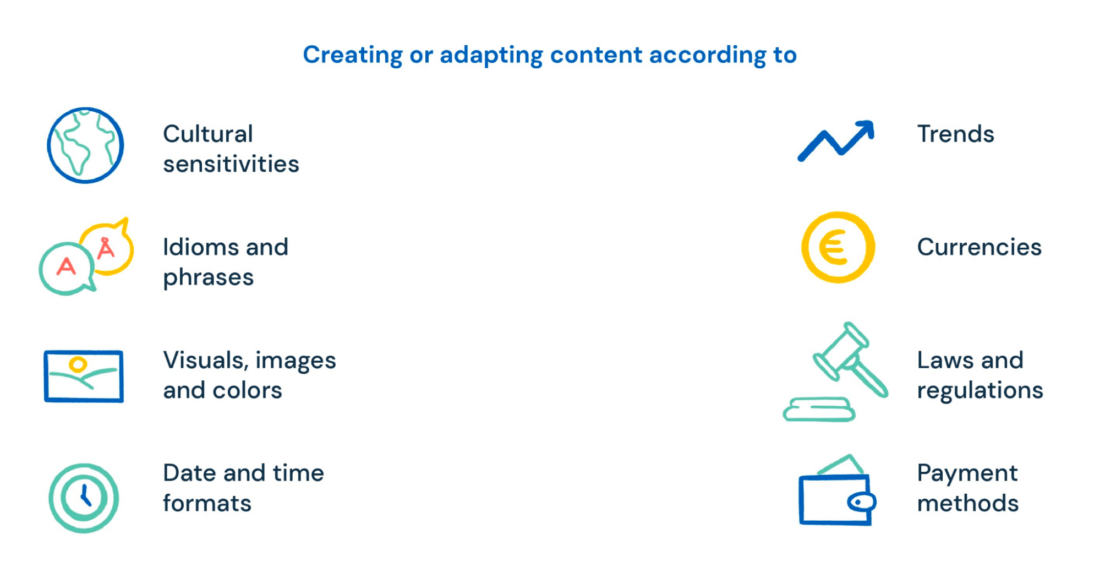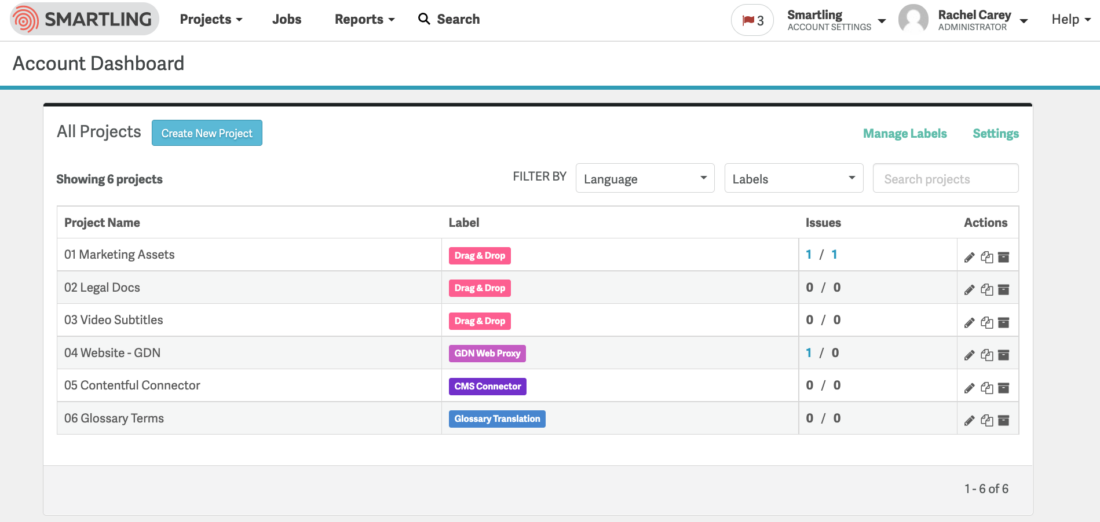Content localization is the portal to a whole new world for your brand. Expanding your online presence and engaging with customers on a deeper level is not just a luxury, but a necessity for survival in today’s changing digital landscape.
In this article, we will talk about content localization and its significance before discussing how to build a strategy for your brand. Once you’re finished reading, you’ll be able to ensure your company’s reputation is trustworthy and recognized anywhere, from vast metropolitan cities in North America, to small, sleepy villages in Mongolia.
What is content localization?
Content must resonate with its audience to make its intended impact. Just like how phrases and idioms don’t always make sense in different geographical areas, you can’t expect one iteration of content to mean the same to everyone reading it. 64% of buyers value localized content, so it’s definitely worth putting in the resources.
In some cases, your content doesn’t tap into their personal views, wants, or needs. In others, it seems totally out of touch – almost like it’s from another planet!

With content localization, companies must be prepared to change their wording and imagery in order for it to be not only impactful but also accepted worldwide. The last thing you want to do is accidentally insult an ethnic group or have a slogan that translates into something explicit.
Many people confuse content localization for translation, but they are quite different:
- Translation: When words are converted from one language to another without changing context, meaning, and purpose.
- Content localization: Concerned with cultural nuances and regional context, which means that, in a way, some words will be translated, but not with the same intent.

Examples of poor content localization
To see how damaging (and hilarious) poor content localization is, here are some examples of when companies didn’t really think it through before publishing.
IKEA
Most of us know that IKEA is a Swedish company with interesting product names when pronounced in English. This is a rather innocent situation, but it still caught people’s attention.
Fartfull is “full speed” in Swedish, but it doesn’t quite carry the same meaning in the Western world. So, when they released their ‘Fartfull workbench’, it made for an amusing advertisement.
Reebok
The athletic wear company, Reebok, made quite the oopsie in 2012 when they advised people to “Cheat on your girlfriend, not your workout.” As you can imagine, it was offensive and distasteful, and Reebok was heavily encouraged to remove the ad campaign, which was only released in Germany.

Perhaps they were going for the shock value, but either way, it did not paint the company positively, even though they stated, “Reebok does not condone this message or cheating in any way.”
Orange
The mobile company Orange is a prime example of how poor content localization can be extremely damaging to the company’s brand, especially when politics and religion are involved.
Almost 30 years ago, Orange launched an advertising campaign with the tagline “The Future’s Bright, the Future’s Orange.” It doesn’t sound too bad – unless you’re Irish.
The phrase is similar to that used by the Unionist community in Northern Ireland, where orange represents Protestantism and British identity. Thus, in the context of Northern Ireland’s troubled history of sectarian conflict between Catholics and Protestants, this slogan conjured up lots of controversy.
Why is content localization so important?
Adapting content to meet specific needs, cultures, and languages creates a more personalized and meaningful experience for your target market, no matter who they are or where they come from. It demonstrates that their language, traditions, and values are respected and understood, which builds trust and strengthens your relationship with them.
Content localization also plays a big part in search engine optimization (SEO). Search engines want to provide users with content most relevant to their needs. When companies localize content correctly, it addresses specific terms, requirements, and cultural contexts of the target market and ranks higher in search results.
Additionally, localized content will contain relevant keywords unique to that corner of the world. By pertaining to SEO rules, companies can increase their website traffic exponentially.
If a company didn’t use content localization, they would see the following issues:
- Limited market reach: Effectively reaching and engaging international audiences would be difficult for companies, and their market growth opportunities would be severely limited due to language barriers and cultural differences.
- Poor customer experience: Non-localized content can foster confusion and frustration among customers. This can result in a negative user experience which puts people off long-term.
- Reduced customer engagement: Failure to resonate with local markets leads to a reduction in customer engagement. Without localization, companies risk losing potential customers and weakening their overall brand impact.
- Brand reputation: Unfortunately, companies can come across as insensitive, offensive, and ignorant if they aren’t careful with their language and imagery. This can damage their brand reputation and hinder their ability to establish trust and credibility in foreign markets.
- Missed revenue: Companies don’t last long without revenue, and if they bypass localization efforts, they risk failing to tap into global markets and connect with international customers.
- Competitive advantage: If your company isn’t making an effort, you can best believe that others are. Competitors with well-localized content can establish stronger connections with international customers and increase market share.

Building your content localization strategy
The content localization process is not as straightforward as you may think. Localizing content requires a deep understanding of cultural sensitivities and norms. Certain phrases, symbols, or visuals that are acceptable in one group may be offensive in another.
However, although it may be challenging to begin with, it is incredibly rewarding for everyone involved. For companies building their strategy, here are the steps required for the best results.
1. Define target markets
This is the first step in building a strategy. As a company, you must have clear goals, which include identifying and understanding your target market in different countries.
When making these decisions, cultural relevance, language preferences, and market potential should all be considered. Once you do this, the whole process will be much more efficient and effective. After all, there’s no use wasting valuable resources on a market that won’t resonate with your services.
2. Market research
Now that you have your target market in your sights, it is time to research, research, research!
You must understand everything about their:
- Cultural nuances
- Preferences
- Needs
- Common language confusions
- Laws regarding advertising and marketing
The best way to do this is to get stuck in and learn from the source through surveys, focus groups, and more.
With this valuable, relevant research, organizations can make informed decisions about content adaptations and ensure that localized content resonates effectively with the target audience.
3. Evaluate existing content
You likely already have content lined up and ready to go, but make sure to thoroughly check which aspects need to be changed before you go any further.
By analyzing existing content, you can identify which parts need adaptation and customization to resonate effectively with new audiences in different regions. This will help put into perspective how much work you have ahead of you.
4. Pick localization methods
This stage is all about deciding how you will adapt, translate, and customize your content to resonate with the target audience. Choosing the best localization methods ensures that content is effectively tailored to meet the new market’s cultural and linguistic needs.

5. Collaborate with professionals
This brings us to the next stage: collaborating with skilled professionals to achieve established content goals. Local experts in the native language will give you the best insight into what should and should not be mentioned.
Professional translators and native speakers can also ensure that your content retains the same meaning when you need to convert from one language to another. For example, the brewing company Coors accidentally fell victim to this as their slogan was “Turn it Loose!” which translated to “You will suffer from diarrhea” in Spanish.
6. Use content management systems (CMS)
You must also be experienced with implementing content management systems (CMS) to optimize your localization workflow. These platforms provide features like collaboration, translation management and progress, and version control to make everything much easier.
With these facilities, all content will be localized with the same style guides applied in earlier stages. As well as this, the ability to easily communicate with localization team members ensures that everyone is on the same page and deadlines are met.
7. Test and refine
You’re not done quite yet. Now, you must evaluate the effectiveness of your localized content and use feedback to make changes if needed. User testing is vital in finding areas that need adjustment because it’s as close to the real deal as you can get.
8. Measure return on investment (ROI)
Finally, after these steps, it is time to let your content out into the world, measure your marketing strategy, and evaluate your localization effectiveness. Additionally, measuring your ROI can determine whether your strategy was cost-effective.
Plenty of expenses are involved in content localization, such as cultural adaptation, technical infrastructure, and translation services. It also gives insight into what elements of the localization project is performing well, such as market reach and improved conversion rates.
Content localization tools
The road to a successful content localization strategy can be a long one full of ups and downs, especially if a startup needs to tap into a global audience in different languages. There’s very little margin for error, and it’s easy to slip up and fail before anything has really begun.
So, to make this process simpler and more cost-effective, here are some of the best localization platforms on the market today. Remember that this technology should be used with professional translators, as this is the only way to have complete assurance of the quality of your content.
1. GlobalLink
GlobalLink has been providing expert localization services and translation management for decades. They state that those using their platform save 50% in pricing, timeline, and translation costs. If that wasn’t enough, over 90% of their clients achieve ROI in less than a year.
How do they do it? One of their biggest strengths is that they automate projects with advanced AI, saving lots of money and time in the process. GlobalLink also provides a quick, easy way to see how your project is doing online instead of rummaging through jumbled emails.

They have a big collection of translators from different professions, including doctors, engineers, and lawyers, and they are all native speakers of the target language.
This is aided by their glossary and terminology management system that stores common terms and phrases companies use on landing pages, social media apps, and in their marketing content. This ensures that your quirky slogans and imagery that make a strong global brand are translated properly and retain your unique tone of voice.
2. Smartling
Smartling is a fantastic tool to help you with localization. Their service analyzes every aspect of your content to check that it resonates correctly with your target audience, regardless of background.
It’s more than just a translation tool; Smartling understands that there is a lot more that goes into successful content localization and takes care of the following elements:
- User interface: A company’s user interface (UI) should reflect adaptations to suit cultural norms and preferences using imagery, colors, and icons. A UI should also be consistent in different international markets and currencies.
- Tone of voice: Smartling will gather as much information as possible about your company and gauge whether the chosen tone of voice suits the target audience.
- Imagery: Imagery is used in areas other than website content; it can be on letter headings or business cards and can do a lot of damage if they happen to be offensive. Smartling won’t ask you to change the whole thing, just certain elements to fit different countries.
- Formatting: Smartling also covers minor details other platforms would not, including date, time, measurement, and number formatting. These differ worldwide and can be quite confusing if a Chinese date format is used in Italy, as they are in the opposite order.
- Payment method: This is especially important if you are an e-commerce site. Smartling will adjust to localized payment systems based on location and currencies.

3. Lokalise
If you want something speedy but still very effective, look no further than Lokalise. Huge brands such as Mastercard and Starbucks have used their services, and we all know how loved they are worldwide.
This platform works incredibly fast because it is easy to use and seamlessly encourages real-time collaboration. This is done via their online translation editor that anyone in the team can work on at any time, assign tasks, and track progress.
For increased accessibility, Lokalise offers plugins to optimize the whole workflow through Adobe XD, Sketch, and Figma. If you are still guessing whether this platform is right for you, there is a 14-day free trial to make use of.
4. Phrase
Phrase is a goldmine for those needing help with content localization; they explain what it is and why it matters and display many different services, including integrations and machine translation.
Phrase will walk you through step by step, which helps simplify the whole process and get the best out of their product. With this workflow automation tool, you can have multiple projects happening simultaneously and never get confused or delayed.

Depending on what caters best to your needs, they have three main products that users can pick from:
- Phrase Suite
- Phrase TMS
- Phrase Strings
If you’re not sure which one is right for you, there is a quiz on their site that will advise you in no time.
Like Lokalise, the great minds at Phrase are also providers of plugins and integrations such as WordPress, Zendesk, and Figma.
5. LingoHub
Finally, we have LingoHub, which focuses on translation more than anything else. This is very useful for creating relevant content in new languages when you have a big team to keep track of.
You also never have to worry about boring tasks such as content updates again, as LingoHub automates the dull parts to leave you with only the exciting ones. All the tools your team could need are right there on the platform, like prefilling, translation memory, and machine translation.
With LingoHub, companies can even localize games, design files, documents, and more. With LingoChecks, anything you translate is scanned for quality issues and errors by using extensive research from Google Translate, DeepL, and Amazon Translate.

Key takeaways
Content localization is much more than throwing in some local slang words here and there; it involves thorough research and understanding of how each culture resonates with particular content. Symbols, colors, and phrases can cause offense, which is incredibly detrimental to a company’s brand and sets you back to square one as you try to build that trust.

Luckily, there are many tools and platforms out there that make the process easier. And, with the help of experienced professional translators, you will open up a whole new market over and over again as long as you respect their language and beliefs.
All in all, despite requiring time and resources to make it work, the reward is substantial for both parties when content localization is done right.









